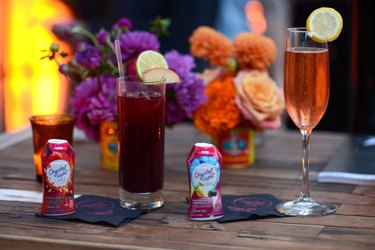
Crystal Light is a low calorie, powered drink mix. It comes in a variety of forms and offerings including on-the-go powders and caffeinated varieties in more than 35 different flavors. Most flavors have 5 calories per serving although the Pure and caffeinated lines have 15 calories per serving.
What is the Artificial Sweetener Used in Crystal Light?
Video of the Day
Some flavors of Crystal Light contain an artificial sweetener called aspartame. There is some controversy surrounding the safety of aspartame due to some conflicting results from animal and human studies. The Food and Drug Administration has deemed aspartame safe for consumption. The artificial sweetener was also addressed in the 2015 Dietary Guidelines, which concluded that, "aspartame in amounts commonly consumed is safe and poses minimal health risk for healthy individuals without phenylketonuria (PKU)." If you're concerned about drinking aspartame or artificial colors, the Pure line might be for you. Truvia is used as a sweetener instead.
Video of the Day
Citric Acid in Crystal Light
Crystal Light contains citric acid which is widely used, safe and versatile. It's used in products like ice cream, fruit juice and other beverages to add flavor. Citric acid is naturally occurring in berries and citrus fruits.
Crystal Light and Caffeine
Crystal Light has a caffeinated line which includes flavors like Concord Grape, Peach Mango, Citrus and Wild Strawberry. Each serving offers 30 milligrams of caffeine, about the same amount that can be found in a can of Coca-Cola. The caffeine found in a cup or two of brewed coffee is safe for most people. Side effects of caffeine can include jitteriness and trouble sleeping.
What are the Artificial Colors Used in Crystal Light?
The Classic and caffeinated Crystal Light lines contain artificial colors including Red 5, Yellow 40, Red 40 and Blue 1, etc. There is conflicting research on the safety of these artificial colors however the FDA has deemed them safe for consumption. If you're concerned about artificial colors, the Pure line, which uses dried fruits and vegetables for color may be a better option.